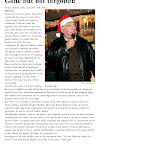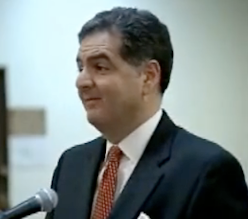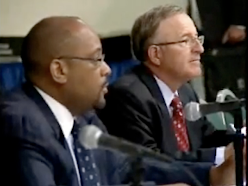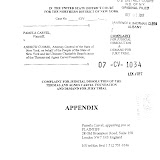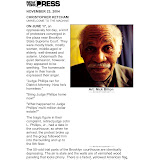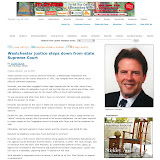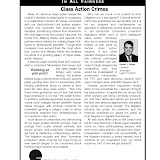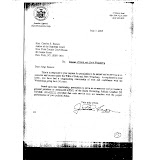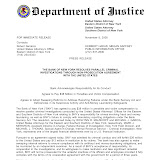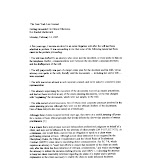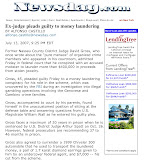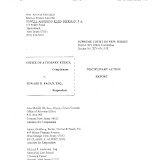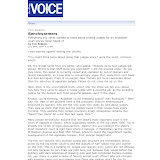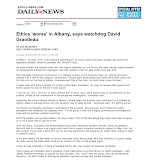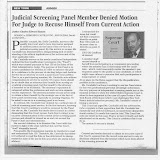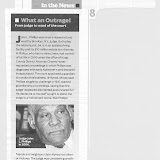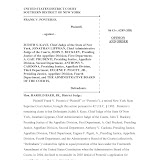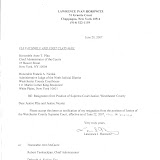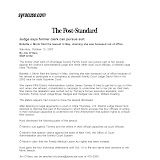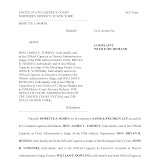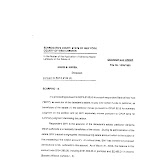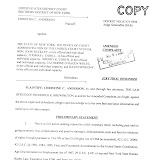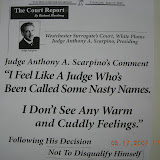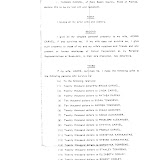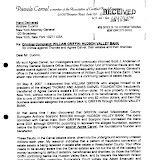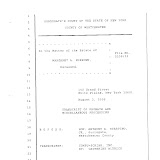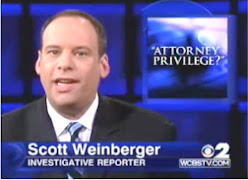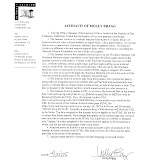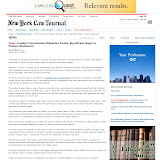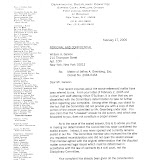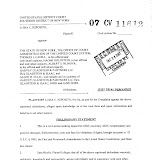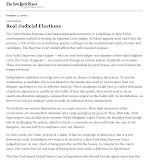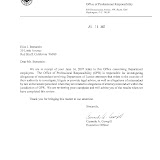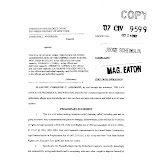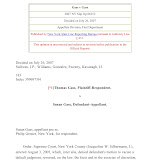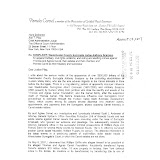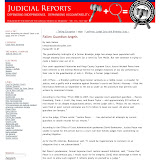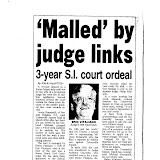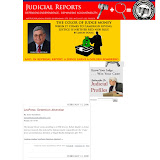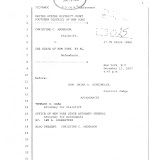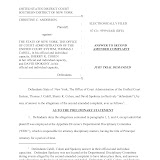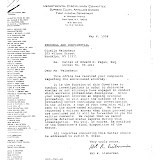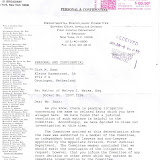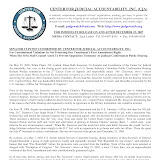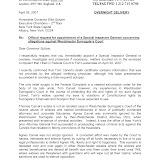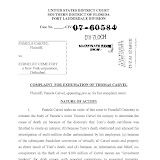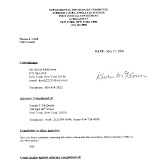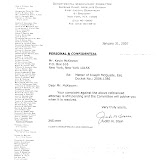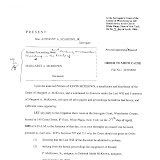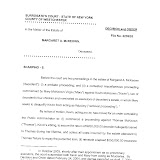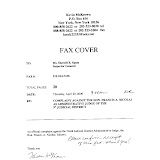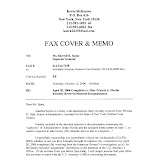Justice has not been served in the case of my dearly departed friend, the Honorable Judge John L. Phillips, known to all as the Kung-Fu Judge. Upon learning of his candidacy in 2001, Brooklyn D.A. Joe Hynes filed an ex-parte (secret action) to seal up all of Judge Phillips' assets. Twelve apartment buildings and two movie Theatres were part of the millionaire judges' empire. The Court then appointed Hynes former Chief of Staff, Harvey Greenberg, as Judge Phillips' "Guardian." The transcript of the proceeding to condemn Judge Phillips is chilling. The reason presented to the court for a guardian was a videotape presented by a prosecutor from the Brooklyn DA's office, Steven Kramer, who conducted a raid on Judge Phillips home along with three confederates. A.D.A. Kramer produced a videotape of the raid at the hearing, and the chief piece of evidence to appoint a guardian was that Judge Phillips had "campaign posters" in his house. These facts are not in dispute. I've read the transcript. Judge Phillips was then remanded to a nursing home...in the BRONX, and the race for District Attorney was over. All of Judge Phillips' properties were sold for pennies-on-the-dollar. Then the judges' home mysteriously burned to the ground, obfuscating any records he had been keeping. The guardians neglected to pay the insurance. Six years later, the once museum-like four story brownstone at 155 Herkimer Street still sits in the heart of Bed-Stuy as a boarded up shell. A monument to the tragic end of the Kung-Fu Judge. Now, the undisputed facts, according to the IRS, are that between the years of 2000 and 2007, four separate guardians sold $10 million dollars of Judge Phillips' property and failed to pay or file any taxes. The IRS now wants $3 million in unpaid taxes from Judge Phillips' estate. The only item left in the estate is the Slave Theatre, which is worth close to 3 million dollars. The four guardians, all attorneys, are:
1. Harvey Greenberg (former chief Assistant District Attorney to D.A. Hynes);
2. Frank Livotti
3. Raymond Jones
4. Emani Taylor
The sale of Phillips' properties was absolutely unlawful and illegal, so why not rescind those sales, restore those properties to the estate of John L. Phillips, and transfer the burden of those unpaid taxes to those four "guardians" who fattened themselves on the fat of Judge Phillips' properties? I would liken those "guardians" to the many suitors of Penelope, Odysseus' estranged wife in the Odyssey, while Poseidon kept the hero away from home. I'm proud to announce that attorney John Kennedy O'Hara has a $10 million lawsuit pending against the nursing home that held Judge Phillips hostage on the orders of DA Hynes. O'Hara also met with federal agents from the IRS last week concerning a criminal probe regarding Phillips' properties, and those four guardians who "forgot" to pay the taxes on the 10 million dollars. The undisputed facts of the case: Judge John L. Phillips, died homeless and broke. He owned 12 apartment buildings and 2 movie theatres. The Brooklyn D.A. seized his assets because Judge Phillips was planning to run against him in 2001. D.A. Hynes got the courts to appoint his former chief of staff as a guardian. All 4 guardians sold all of Judge Phillips' buildings, and kept the money. These facts are not in dispute. I've read the court documents. The New York Times, New York Post, Brooklyn Paper, and The New York Sun ran a series of articles. In addition, Christopher Ketcham wrote an excellent article in the Brooklyn Rail, and AARP Bulletin. I mentioned the Odyssey earlier. It seems that Hynes, playing the part of Poseidon, was successful in his campaign to kill our hero, Judge John L. Phillips, and the suitors have all but eaten his property. Can John Kennedy O'Hara, playing the part of Telemachus, bring some modicum of justice to the estate of Judge Phillips? May we see justice served to the legacy of Judge John L. Phillips, the Kung-Fu Judge of Brooklyn, beloved by his tenants, his friends, and this writer.
******************
The Slave Auctions and the End of the Kung-Fu JudgeThe Brooklyn Rail by Christopher KetchamOn Feb. 6, the Brooklyn Supreme Court announced that it would soon begin auctioning off the storied Slave Theaters I & II in Bedford Stuyvesant, where black activists in New York once gathered to speak and protest. The judge overseeing the case had assured the erstwhile owner of the properties, John Phillips, himself an African-American ex-Brooklyn Civil Court judge, that only the Slave II, the lesser of the properties, would be sold. But it wasn’t so. Phillips, 83, had been through this wringer before. Readers of the Rail may recall my article last summer, “Erasing the Kung-Fu Judge” (July/August 2007), which tracked the elderly retired judge’s seven-year odyssey in a court system that skillfully leeched his multi-million dollar estate. Phillips in the end was left homeless and destitute at the hands of court-appointed guardians. Rude thanks from the Brooklyn judiciary that he served honorably for 13 years, until age 70—a kind of perfectly perverse repudiation of his career as lawyer, jurist, kung-fu instructor, agitator, friend to Paul Robeson, rebel loner in Brooklyn politics, and self-made man presciently buying up property in the heart of Bed-Stuy. Phillips’ fall came at the hands of Brooklyn District Attorney Charles “Joe” Hynes. Aging, eccentric, and always the rebel, Phillips wanted to challenge DA Hynes for his seat during election-year 2001. Hynes responded by asking a friendly judge to declare Phillips “mentally incompetent.” Phillips’ assets were frozen so he could no longer cover mortgage, buy food, or pay utilities. Reams of his personal papers were forcibly taken away by agents of DA Hynes—Phillips the martial artist even scuffled with the men as they rifled his records—and, in 2002, his heat was shut off in the depths of winter. By the end of 2004, fast sickening from his ill treatment, Phillips had been physically removed from his Bed-Stuy home and deposited in a nursing facility in the northern Bronx, far from his neighborhood and friends, stuck in a dismal little room where he was barred from receiving visitors. Fitted with an electronic tracking bracelet, he watched on television in November of 2004 as his Brooklyn home was gutted by a suspicious fire.
Not long after my article appeared in the Rail last summer, events seemed to turn in Phillips’ favor. He had been moved from his Bronx cage to a modest apartment in an assisted living facility in Park Slope, on the ninth floor of the building, with a view of Prospect Park and the Brooklyn Botanical Gardens. The Hon. Michael Pesce, the judge and friend of Hynes who for seven years had overseen the Phillips case so ineptly—or, perhaps, corruptly—recused himself at last from all dealings in the matter, handing oversight of Phillips’ money to a colleague with a less tarnished history. At the same time, a grand jury led by an investigator under Hynes was looking into criminal charges against one of the most prolifically larcenous of the “guardians” of the Phillips estate, a lawyer named Emani P. Taylor, who helped herself to over $1 million from Phillips’ pockets. There the good news ended. Though the state’s top legal disciplinary committee in November disbarred Taylor for her actions in the Phillips case – her misconduct, the committee reported, “immediately threatens the public interest” – Hynes announced in January that no criminal charges would be filed against her.Given the facts then available—the facts that remain today as disturbing as ever—DA Hynes might have taken the high road: He could have admitted his own culpability in the Phillips’ fiasco and investigated Emani Taylor along with Justice Pesce and the three other guardians who colluded in plundering Phillips’ estate (among them Hynes’ long-time confederate and former campaign treasurer Harvey Greenberg, a Park Avenue lawyer). Together, the guardians under Hynes’ and Pesce’s watch had liquidated $10 million in property through what appeared to be rigged sales. They had commandeered Phillips’ pension and social security checks. They refused to pay his utilities even though he could not do so. In violation of both state and federal law, they failed for seven long years to file a single accounting of his estate or pay a single tax return, leaving Phillips $2 million in debt by the end of 2007, according to court documents citing the IRS. It was enough to kill a man as old and busted-down as Judge Phillips. But Phillips hung on—which no one who looted his estate had reason to be thankful for. There is evidence that the Phillips case is not an isolated incident. Multiple sources with inside knowledge of courthouse affairs tell me that as many as 150 cases that Justice Pesce oversaw in recent years have been removed from his purview because of undisclosed problems uncovered by the state Office of Court Administration. One of the reasons for the OCA’s action, according to sources, was the suspicious pattern of appointments under Pesce’s watch. In one case, for example, Pesce handed 17 guardianships in a single day to a 38-year-old attorney named Dagmar Plaza, whose husband works as an assistant district attorney under Joe Hynes. As in the Phillips matter, rules for handling such guardianships appear to have been disregarded: Conflict of interest firewalls were ignored, as were state laws requiring that guardians file full accountings of the estates, while monies went unaccounted for.
In the meantime, it remains a mystery as to why Pesce recused himself from the Phillips case in the first place. That Hynes has failed to set his hounds on the trail is no surprise. What’s odd is that federal prosecutors refuse to take a look at the foulness of the Brooklyn courts when it comes to handling the estates of the elderly. John Kennedy O’Hara, a Brooklyn activist who had also fallen far at the hands of DA Hynes—O’Hara in 1997 was selectively prosecuted under an obscure statute and disbarred as a lawyer—visited his old friend Judge Phillips at the new apartment in Park Slope pretty much every week after Phillips was transferred there in the summer of 2007. It was O’Hara who during that hot summer organized a demonstration of Phillips’ supporters in front of Justice Pesce’s home in Carroll Gardens. The dozen or so protestors held signs and chanted and walked up and down before Pesce’s gated front garden. A veteran of the trench warfare of Brooklyn ethnic politics, O’Hara made sure they misspelled Pesce’s name—“PESH IS A THIEF!” the signs cried—because, he explained, “Brooklyn Italians hate it when you don’t spell their names right.” At last, with Pesce a no-show, the protestors, abandoning the picket, mashed the signs like scarecrows into the iron bars across Pesce’s front yard. A courthouse associate who O’Hara knew from his days as a lawyer told him that it was “unseemly” to mount a protest in front of a sitting judge’s home. “Unseemly? Judge Phillips doesn’t have a home,” O’Hara replied. It was the least he could do for his friend. O’Hara was a different color, half Phillips’ age, born almost a world away in lily-white Bay Ridge, but as a 15-year-old in 1976 he heard about Bed-Stuy’s Kung-Fu Judge and his run for the civil court bench—the rebel battling the Brooklyn Democratic Party machine alone. That summer O’Hara rode his bicycle the six miles from Bay Ridge to Bed- Stuy almost every day. The disco hit “Kung-Fu Fighting” was the anthem: They blasted it from megaphones atop the campaign’s sound trucks. On a February evening not long ago, O’Hara stood in the lobby of the building waiting for Phillips. He was upbeat. A few days earlier, on January 29, O’Hara had filed a complaint to Governor Eliot Spitzer outlining the criminality in the Phillips matter and asking Spitzer to use his special mandate as governor to appoint a special prosecutor free of local influence. It was late, after dinner, and Phillips was just getting back from court. O’Hara had never seen him look so drained. “They’re selling the Slaves,” said Phillips.
The Slave Theaters, in Bed-Stuy, were Phillips’ prize properties. He bought them in 1975, because at the time he needed a venue to screen a movie that he’d written and produced (he spent $185,000 of his own cash on the project—Phillips was not a man easily deterred). The film, Hands Across Two Continents, concerned the still-taboo matter of inter-racial love, though it also boasted a scene in which four black women in space suits chained a white man in a bed and stuck dynamite up his ass. In the flick, Phillips then blew up a whole building to bring home the effect. The movie didn’t do so well, but the Slaves later became a nexus for black firebrands like Al Sharpton. “The Slaves are goin’,” said Judge Phillips again. “I know, judge,” said O’Hara. “We’re gonna fight this thing.” O’Hara joined him in the elevator to the room on the ninth floor, and Phillips invited O’Hara for dinner. The room was clean, quiet, but the couch was old and frayed, the chairs stunk of urine—overused, they had made the rounds of the senior center. The arbiters of Phillips’ estate over the years had refused to shell out money for such largesse as furniture not pissed on; at one point his guardians had even refused to buy Phillips a winter coat to fend off the cold. A week later, on Feb. 15, O’Hara was on the phone with fashion designer and philanthropist Marc Ecko, who had taken an interest in Phillips’ case and now had bought him a new couch and two chairs, delivered that morning. O’Hara then gave his friend a call. “Judge,” O’Hara asked, “how do you like the new furniture?” It was early evening, but Phillips was already half-asleep. The previous week in court had been long—five days straight of wading through the mess of his affairs. “The furniture?” Phillips said. “Oh yes. Very nice, very nice.” O’Hara sensed he didn’t want to talk. “Judge, I’ll come by to see you next week,” he said. There was a pause. “You take care, good buddy,” Phillips said. Then they hung up. The next day, Feb. 16, Phillips died. He collapsed in the elevator, victim of a heart attack. The New York Times carried an obituary, with a photo, on the following Monday. No mention was made of the crooks in the courthouse who poisoned his twilight years.
Christopher Ketcham, a freelance writer for Harper's, GQ, Mother Jones and many other magazines, divides his time between Brooklyn and the redrock country of Utah. He can be reached at cketcham99@mindspring.com.



